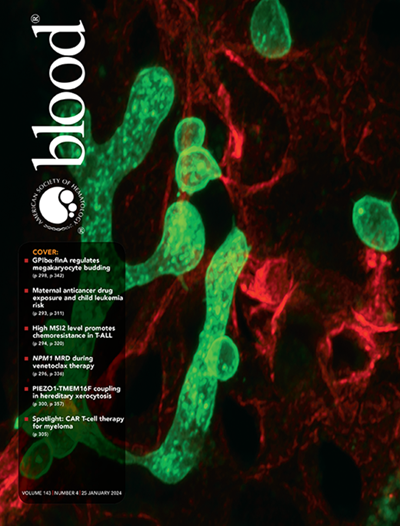IgM-MGUS与稳定或进行性无症状Waldenström巨球蛋白血症患者的基因组图谱
IF 23.1
1区 医学
Q1 HEMATOLOGY
引用次数: 0
摘要
未确定意义的igm -单克隆γ病(IgM-MGUS)和无症状Waldenström (aWM)是症状性Waldenström巨球蛋白血症(sWM)的前体疾病,每年有1.5-12%的进展风险。尽管存在风险分层的临床预后模型,但区分最终会进展的无症状患者与不会进展的患者仍然具有挑战性。因此,对形成疾病进展的基因组特征进行表征可能会潜在地改善风险分层。我们对139例患者的232个样本进行了全外显子组测序,其中包括9例序列样本患者。我们观察到,在疾病进化的各个阶段,突变负担不断增加。与非进展性aWM组(aWMst)相比,进展性aWM组(aWMpr)中CD79B、ARID1A和CREBBP等基因更常发生突变,而MYD88L265变异等位基因频率(VAF)在aWMpr中显著高于aWMst患者。此外,与MYD88MUT患者相比,MYD88WT基因型的IgM-MGUS患者表现出不同的基因组谱。此外,更多的非整倍体的存在显示出与有症状疾病进展的高风险显著相关。总的来说,我们的研究表明,在aWM诊断时对患者的肿瘤进行基因组分析可能代表了一种识别高风险进展患者的改进策略,这些患者可以从早期干预中受益。本文章由计算机程序翻译,如有差异,请以英文原文为准。
Genomic landscape of IgM-MGUS and patients with stable or progressive asymptomatic Waldenström macroglobulinemia.
IgM-Monoclonal gammopathy of undetermined significance (IgM-MGUS) and asymptomatic Waldenström (aWM) are precursor conditions of symptomatic Waldenström macroglobulinemia (sWM) with an annual 1.5-12% risk of progression. Although clinical prognostic models exist for risk stratification, it remains challenging to distinguish asymptomatic patients who will eventually progress from those who will not. Hence, the characterization of genomic features that shape disease progressors could potentially improve risk stratification. We performed whole-exome sequencing on 232 samples from 139 patients, including 9 patients with sequential samples. We observed an increasing mutation burden through the stages of disease evolution. Genes such as CD79B, ARID1A and CREBBP were more often mutated in the aWM progressed (aWMpr) compared to the non-progressor aWM group (aWMst) while MYD88L265 variant allele frequency (VAF) was significantly higher in aWMpr compared to aWMst patients. In addition, IgM-MGUS patients with MYD88WT genotype showed a distinct genomic profile compared to the MYD88MUT patients. Furthermore, the presence of more aneuploidies showed a significant association with a higher risk of progression to the symptomatic disease. Overall, our study shows that genomic profiling of patients' tumor at the time of aWM diagnosis might represent an improved strategy for identifying patients at high risk to progression who could benefit from earlier intervention.
求助全文
通过发布文献求助,成功后即可免费获取论文全文。
去求助
来源期刊

Blood
医学-血液学
CiteScore
23.60
自引率
3.90%
发文量
955
审稿时长
1 months
期刊介绍:
Blood, the official journal of the American Society of Hematology, published online and in print, provides an international forum for the publication of original articles describing basic laboratory, translational, and clinical investigations in hematology. Primary research articles will be published under the following scientific categories: Clinical Trials and Observations; Gene Therapy; Hematopoiesis and Stem Cells; Immunobiology and Immunotherapy scope; Myeloid Neoplasia; Lymphoid Neoplasia; Phagocytes, Granulocytes and Myelopoiesis; Platelets and Thrombopoiesis; Red Cells, Iron and Erythropoiesis; Thrombosis and Hemostasis; Transfusion Medicine; Transplantation; and Vascular Biology. Papers can be listed under more than one category as appropriate.
 求助内容:
求助内容: 应助结果提醒方式:
应助结果提醒方式:


